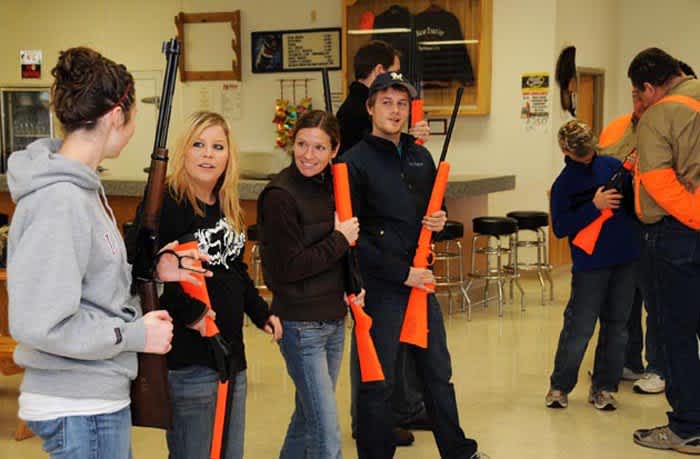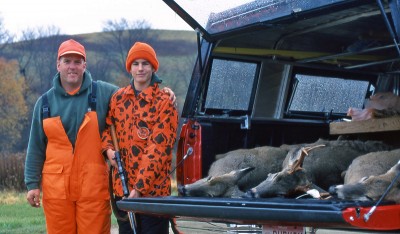Increase in Hunter Numbers Might Be Mirage
Patrick Durkin 04.09.14

Tom Heberlein flipped his newspaper aside, sipped his coffee and said skeptically, “Someone needs to explain these higher hunter numbers rather than simply making happy dances about them.”
It was early October 2012. Heberlein—a rural sociologist who often studied hunters and hunting during a 30-plus-year career at the University of Wisconsin-Madison—was reading an article that said hunting participation increased nine percent nationwide from 2006 to 2011. The article was quoting from the just released 2011 National Survey of Fishing, Hunting, and Wildlife-Associated Recreation.
Heberlein was riding in my truck as we sped northward through Wisconsin on Highway 13 that morning, bound for his shack 30 miles south of Lake Superior. Outside, the tamaracks were smoky-gold, further priming him for grouse.
We were at least 90 minutes from Old T, however, so he had a newspaper on his lap, not his hunting satchel. It’s his habit to read aloud when something catches his interest, and then pitch the paper impatiently while rebutting or discussing what he’s read.

That particular article quoted spokespeople from wildlife agencies and hunting organizations, all oozing satisfaction and self-congratulation that hunter numbers were rising after two decades of decline.
The good news came from data in a federal government survey that’s been done every five years since 1955. In fact, it’s the same survey that documented the 20-year slide. If its data showed increased hunting participation, it had to be true, right?
Besides, everyone wanted to believe it. Agencies, universities, manufacturers, and hunting groups have worked throughout the 2000s to reverse hunting’s decline. Maybe their efforts were making a difference.
Unfortunately, the survey was contradicting real-world numbers. Hunting-license sales in most states remained flat or declining. Further, respected demographers projected continued declines as the US population grows increasingly urban, and baby boomers—hunting’s broadest base—keep aging and leaving the woods, fields, marshes, and forests.
Societal factors like those are far tougher than river barges or aircraft carriers to halt or turn. Hence Heberlein’s skepticism.
But he’s not alone. When the Wisconsin chapter of The Wildlife Society gathered for its annual conference March 12 to 13 in Wausau, two hunter recruitment/retention specialists from the state’s Department of Natural Resources (DNR) advised “extreme caution” in accepting the national survey’s 2011 findings.
Mike Watt and Keith Warnke help run the DNR’s statewide “Learn to Hunt” and “Mentored Hunting” programs. In his presentation March 13, Watt suggested that annual hunter censuses—which most states conduct through license sales—better indicate hunting trends than the government’s national survey, which depends on sampling through telephone interviews.

For instance, the survey reported a 17 percent increase in Wisconsin’s resident hunters between 2006 and 2011, but the state’s actual license buyers declined by one-half percent those years. “Since estimates from surveys can be affected by methodology, terminology, sample size, and response rates, we believe the state data based on actual counts should be used for projections,” Watt and Warnke stated.
Even so, license counts also require scrutiny. For example, some experts didn’t question the national survey because another report found that individual license buyers rose two percent nationwide between 2006 and 2011, with a four percent increase from 14.4 million to 15 million between 2010 and 2011.
However, when Watt and Warnke studied the increases, they attributed 81 percent of the 526,341 boost in 2011’s individual license-buyers to four states: Alabama, Illinois, Utah, and New York. In fact, Alabama and New York generated 66 percent of it. In all four states, the increases were more about procedural changes in license sales than in actual increases in hunters.
In Alabama, until the 2007-2008 hunting season, a license became valid the day of purchase and expired one year later. By spreading license sales over two autumns, hunter numbers appeared lower than actuality. After switching to a September 1 to August 31 license, Alabama’s individual hunters leapt from 264,710 to 540,098.
Meanwhile, New York relaxed its laws in 2008 to allow those under age 16 to buy a deer license. This allowed nearly 80,000 buyers to start hunting earlier than they otherwise would have, boosting individual licenses from 597,006 to 676,669.
Warnke said he and Watt dug into the license data because it’s important for those involved in hunter recruitment and retention to view participation data objectively.
“One data point does not make a trend,” Warnke said. “Cheering that 2011 finding is like declaring victory at halftime. It doesn’t mean anything unless we see another increase in the 2016 survey. We still need to find more cost-effective ways to develop new hunters. If we don’t, we could see another decline in 2016, and it will be worse if we let premature celebrations reduce our efforts now.”

